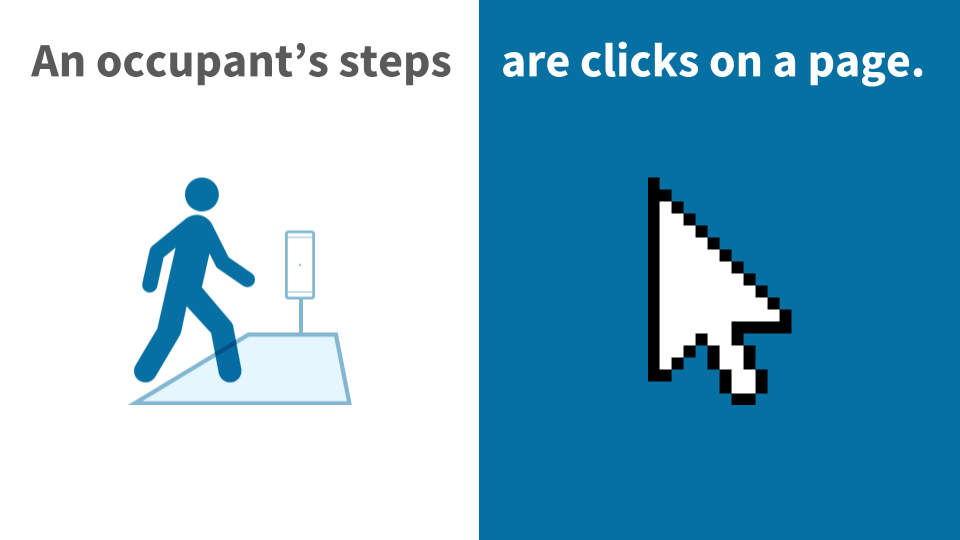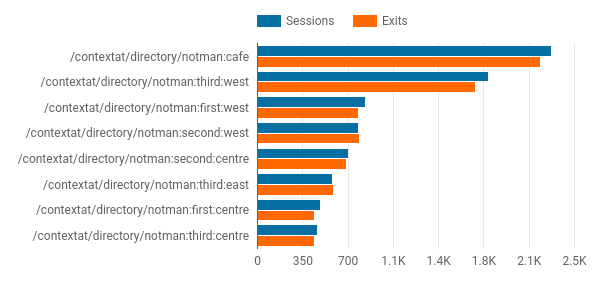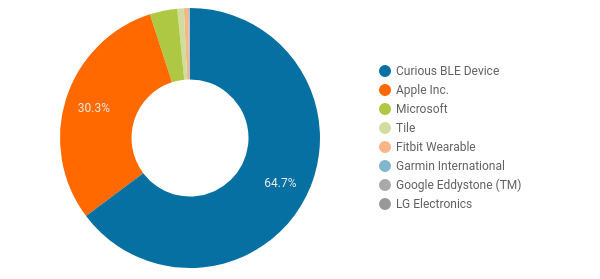Google Analytics for the real world. Several companies have self-identified as such. We ourselves have written a blog post entitled Google Analytics for the Physical World. But what happens when you literally run real-world behaviour data through tools designed for the web?
The above screenshot shows what happens when we do exactly that, using Notman House in our native Montréal as the test subject. The dashboard (shared here) was created using Google Data Studio based on data from Google Analytics (GA), industry-standard tools for measuring behaviour on the web. The source data, however, has nothing to do with the web.
Since 2012, we’ve had our infrastructure deployed at Notman House. Each of the orange dots in the above image represents one of our sensors: there are three on each floor, plus one in the café (not shown). These ten sensors detect, among other things, the Bluetooth signals of smartphones and wearables carried by the occupants of the house. Our Pareto SaaS relays this real-time location data to GA.

In web parlance, we’ve modelled Notman House as ten web pages with users being not the humans themselves, but rather their Bluetooth-emitting smartphones and wearables.
An obvious shortcoming is the fact that many people keep Bluetooth disabled on their phone, while conversely, an increasing number of people are carrying multiple Bluetooth devices: uniquely counting each human is impractical. But when you’re capturing 1000+ daily sessions, the trends certainly pervade as we’ll now show!
Hourly “occupancy” analytics

The daily occupancy cycle of Notman House is consistent week over week (dark blue vs. light blue bars), and concentrated between the hours of 8am and 7pm (graph is GMT, hence shifted 5 hours from local time), both of which agree with observation.
Sessions per page

User sessions were far more likely to include the Café and the 3rd Floor West, which is consistent with observation as both are event spaces which routinely attract the most occupants.
Sessions by device

Similar to how web analytics can be split into desktop/tablet/mobile and browser type, Bluetooth packets often include information about the device type or brand (see Sniffypedia) which may be correlated with user demographics. Indeed we’ve observed seemingly characteristic device distributions based on region and venue (ex: office/store/school).
The verdict?
Can you measure real-world behaviour using tools designed for the web? With little effort, using only the basic functionality of GA, we were able to extract the three highlighted metrics, each of which effectively captures the behaviour of occupants of physical spaces. Imagine the potential when leveraging the extensive functionality of tools such as GA.
Imagine as a retailer creating a Data Studio dashboard which compares e-commerce and in-store behaviour side-by-side.
Now imagine the additional granularity and insights when both people and assets are individually identifiable by opting-in with a mobile app or carrying an inexpensive Bluetooth beacon.
Time and again the web has shown that those who measure outperform. Not only can you measure real-world behaviour using the tools of the web, history suggests that, sooner than later, you definitely should!


Comments
2 responses to “Can you measure real-world behaviour using tools designed for the web?”
[…] Indeed, our own infrastructure has been listening since 2013. We’ve learned a lot since then, patiently waiting for a brilliant solution to the pervasive infrastructure challenge. What’s so exciting today about being a Lunera launch partner is the fact that lighting is the ubiquitous in-building infrastructure. At the flip of a switch, a building can begin to measure the real world like the web. […]
LikeLike
[…] Indeed, we too think this will become a key focus in 2018, as we ourselves predicted (on page 64) that retailers will begin to model their physical operations after their established e-commerce practices, by associating each physical point of interest with its online equivalent: the corresponding product/category webpage. In other words, physical browsing behaviour will be measured and analysed exactly as online browsing behaviour, using the latter’s established set of tools. […]
LikeLike